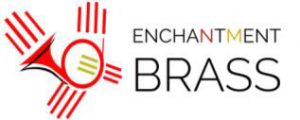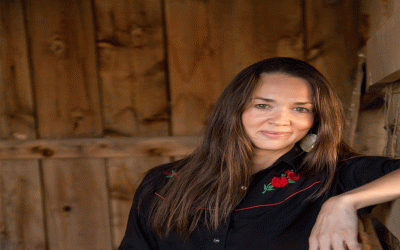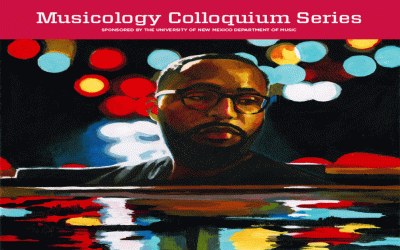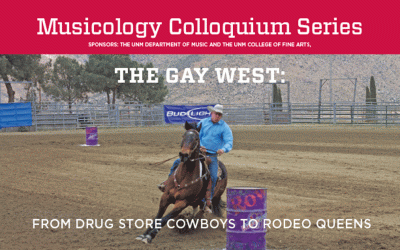 The Enchantment Brass, the brass ensemble-in-residence at the University of New Mexico, has released their debut recording, A Brass Menagerie: The Music of John Cheetham, on all digital formats. The album showcases the brass quintet and brass choir music of New Mexico native, and UNM Distinguished Alumnus, Dr. John Cheetham. It features two world-premiere recordings, Partita Antico for brass quintet, and Eclectix, for brass choir.
The Enchantment Brass, the brass ensemble-in-residence at the University of New Mexico, has released their debut recording, A Brass Menagerie: The Music of John Cheetham, on all digital formats. The album showcases the brass quintet and brass choir music of New Mexico native, and UNM Distinguished Alumnus, Dr. John Cheetham. It features two world-premiere recordings, Partita Antico for brass quintet, and Eclectix, for brass choir.
“The University of New Mexico has long had ties to Dr. Cheetham, from his days as a student at UNM, to his collaboration with the New Mexico Brass Quintet,” said John Marchiando, Assistant Professor of Trumpet. “We are excited to be a part of the legacy of Dr. Cheetham’s relationships with both UNM and the New Mexico Brass Quintet, and are proud to be the ensemble that has the opportunity to bring more of Cheetham’s music to the masses.”
Marchiando, along with UNM Assistant Professors, Dr. Chris Buckholz and Dr. Michael Walker, Associate Professor Richard White, and Lecturer Brynn Marchiando comprise the Enchantment Brass Quintet. Additionally, several of the fine brass students at the University of New Mexico brass area joined the faculty, as the Enchantment Brass Choir, to record two large brass ensemble works for the album. This fulfills part of the mission of the brass faculty to provide career building opportunities for the students at UNM. Director of Bands Eric Rombach-Kendall collaborated as conductor and producer, and Associate Director of Bands, Dr. Chad Simons, participated as an important member of the production team, as well.
The members of the Enchantment Brass are celebrated as some of the finest performer/pedagogues to be found in the United States. The faculty combines the experience gained from performing with world-renown groups such as the Summit Brass, Detroit Symphony, U.S. Army Jazz Ambassadors, Utah Symphony, Baltimore Symphony, Santa Fe Opera, Indianapolis Symphony, Utah Festival Opera, and more, to provide a well-rounded and real-world perspective on training students for a career in music. Enchantment Brass members have performed, and given master-classes and clinics at universities, conferences and festivals worldwide, including the Southwest Horn Conference, International Trumpet Guild Conference, International Tuba Euphonium Association Conference, the Eastern Trombone Workshop, the Rafael Méndez Brass Institute, Chamber Music Campania, Music in the Mountains, Telluride Jazz Festival, and the Thailand Brass and Percussion Conference.
Tubist Dr. Richard White, stated “Recording this album provided me with an amazing musical experience with my colleagues. It is an honor to be a part of a project such as this, which promotes the fine compositions of such a distinguished composer like Dr. Cheetham.”
The recording was paid for with funding received from a Research Allocations Grant from the University of New Mexico. UNM Trombone Professor, Dr. Chris Buckholz, who did most of the composing of the grant says, “We are happy that we could make this project something that features so many facets of the University New Mexico. The funding, the student involvement, the collaboration with Dr. Cheetham, and the fellowship between the faculty who worked on the project, are all indicative of the special place that the UNM Music Department has become. We look forward to having everyone hear the fantastic brass music of John Cheetham!”
Dr. Cheetham, a retired Professor Emeritus from the University of Missouri said “Imagine my surprise to learn that the Enchantment Brass had been awarded a grant by UNM to record some of my brass music (including two world-premiere recordings), the selection of which was a cooperative effort between myself and the brass faculty. I was invited to attend the recording sessions at UNM which was a most rewarding and exciting experience. And I enjoyed returning to my alma mater after nearly 25 years. I was impressed by the professionalism during the process as well as the musicianship and dedication of all the musicians–but perhaps even more by the spirit of camaraderie and mutual respect.”
A Brass Menagerie: The Music of John Cheetham is available now on all digital formats, including iTunes, Apple Music, CD Baby, Amazon Music, Spotify, YouTube, and more!
Ensemble Contact & Press Contact:
John Marchiando, 480-206-0388
jrmarch@unm.edu
Dr. Kristina Jacobsen awarded The Fulbright Con Il Sud Award for Teaching and Research
Dr. Jacobsen, was recently awarded the Fulbright Con Il Sud Award for Teaching and Research to support her upcoming research during her sabbatical year on the Italian island of Sardinia [Sardigna].
Heterophony: Texture, Technique, and Social Commentary
This lecture is in two parts: the first draws from my research on the 1960s jazz avant-garde and musicians’ interests in heterophonic musical textures. For the second part, I perform original music that utilizes heterophony and “noise” in a solo electronic and improvised format.
The Gay West: From Drug Store Cowboys to Rodeo Queens
The masculine ideal represented by the American cowboy is variously interpreted by spectators, dancers, musicians, and contestants at gay rodeos and country western dances across the U.S. Examining embodied gender practices within these communities, this talk articulates the sonic, social, and geographical spaces of the gay American West.



